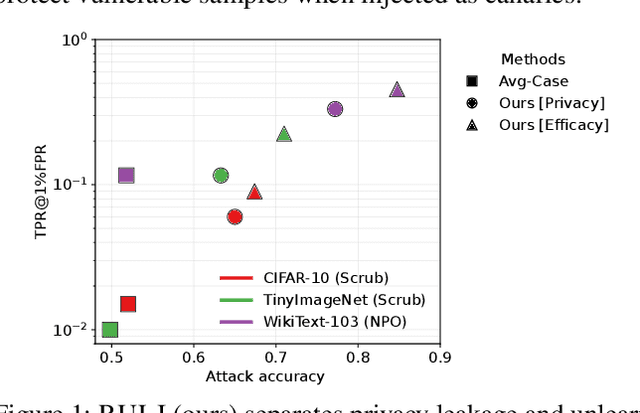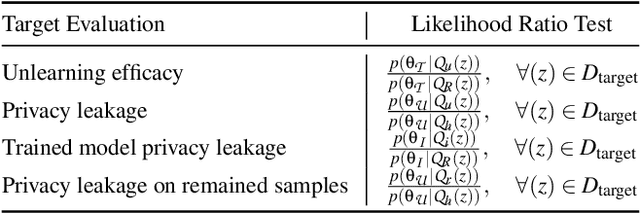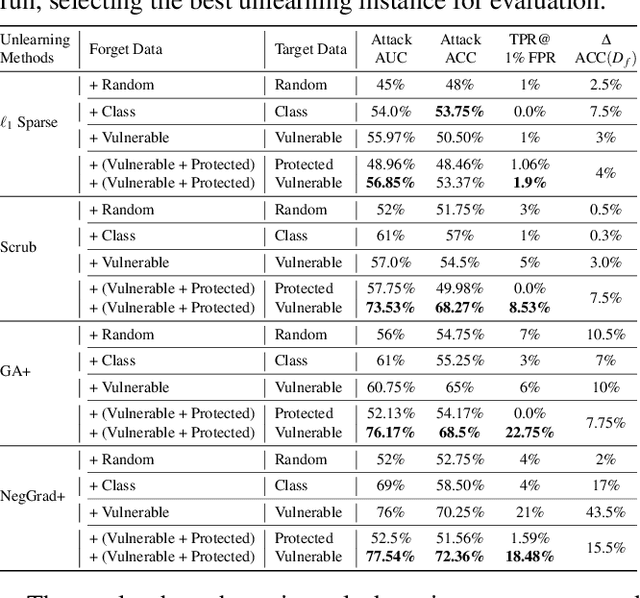Jie Fu
University of the Arts London, Creative Computing Institute, London, United Kingdom
Rectifying Privacy and Efficacy Measurements in Machine Unlearning: A New Inference Attack Perspective
Jun 16, 2025



Abstract:Machine unlearning focuses on efficiently removing specific data from trained models, addressing privacy and compliance concerns with reasonable costs. Although exact unlearning ensures complete data removal equivalent to retraining, it is impractical for large-scale models, leading to growing interest in inexact unlearning methods. However, the lack of formal guarantees in these methods necessitates the need for robust evaluation frameworks to assess their privacy and effectiveness. In this work, we first identify several key pitfalls of the existing unlearning evaluation frameworks, e.g., focusing on average-case evaluation or targeting random samples for evaluation, incomplete comparisons with the retraining baseline. Then, we propose RULI (Rectified Unlearning Evaluation Framework via Likelihood Inference), a novel framework to address critical gaps in the evaluation of inexact unlearning methods. RULI introduces a dual-objective attack to measure both unlearning efficacy and privacy risks at a per-sample granularity. Our findings reveal significant vulnerabilities in state-of-the-art unlearning methods, where RULI achieves higher attack success rates, exposing privacy risks underestimated by existing methods. Built on a game-based foundation and validated through empirical evaluations on both image and text data (spanning tasks from classification to generation), RULI provides a rigorous, scalable, and fine-grained methodology for evaluating unlearning techniques.
Thompson Sampling in Online RLHF with General Function Approximation
May 29, 2025Abstract:Reinforcement learning from human feedback (RLHF) has achieved great empirical success in aligning large language models (LLMs) with human preference, and it is of great importance to study the statistical efficiency of RLHF algorithms from a theoretical perspective. In this work, we consider the online RLHF setting where the preference data is revealed during the learning process and study action value function approximation. We design a model-free posterior sampling algorithm for online RLHF inspired by Thompson sampling and provide its theoretical guarantee. Specifically, we adopt Bellman eluder (BE) dimension as the complexity measure of the function class and establish $O(\sqrt{T})$ regret bound for the proposed algorithm with other multiplicative factor depending on the horizon, BE dimension and the $log$-bracketing number of the function class. Further, in the analysis, we first establish the concentration-type inequality of the squared Bellman error bound based on the maximum likelihood estimator (MLE) generalization bound, which plays the crucial rules in obtaining the eluder-type regret bound and may be of independent interest.
Thinker: Learning to Think Fast and Slow
May 27, 2025Abstract:Recent studies show that the reasoning capabilities of Large Language Models (LLMs) can be improved by applying Reinforcement Learning (RL) to question-answering (QA) tasks in areas such as math and coding. With a long context length, LLMs may learn to perform search, as indicated by the self-correction behavior observed in DeepSeek R1. However, this search behavior is often imprecise and lacks confidence, resulting in long, redundant responses and highlighting deficiencies in intuition and verification. Inspired by the Dual Process Theory in psychology, we introduce a simple modification to the QA task that includes four stages: Fast Thinking, where the LLM must answer within a strict token budget; Verification, where the model evaluates its initial response; Slow Thinking, where it refines the initial response with more deliberation; and Summarization, where it distills the refinement from the previous stage into precise steps. Our proposed task improves average accuracy from 24.9% to 27.9% for Qwen2.5-1.5B, and from 45.9% to 49.8% for DeepSeek-R1-Qwen-1.5B. Notably, for Qwen2.5-1.5B, the Fast Thinking mode alone achieves 26.8% accuracy using fewer than 1000 tokens, demonstrating substantial inference efficiency gains. These findings suggest that intuition and deliberative reasoning are distinct, complementary systems benefiting from targeted training.
Automata Learning of Preferences over Temporal Logic Formulas from Pairwise Comparisons
May 23, 2025Abstract:Many preference elicitation algorithms consider preference over propositional logic formulas or items with different attributes. In sequential decision making, a user's preference can be a preorder over possible outcomes, each of which is a temporal sequence of events. This paper considers a class of preference inference problems where the user's unknown preference is represented by a preorder over regular languages (sets of temporal sequences), referred to as temporal goals. Given a finite set of pairwise comparisons between finite words, the objective is to learn both the set of temporal goals and the preorder over these goals. We first show that a preference relation over temporal goals can be modeled by a Preference Deterministic Finite Automaton (PDFA), which is a deterministic finite automaton augmented with a preorder over acceptance conditions. The problem of preference inference reduces to learning the PDFA. This problem is shown to be computationally challenging, with the problem of determining whether there exists a PDFA of size smaller than a given integer $k$, consistent with the sample, being NP-Complete. We formalize the properties of characteristic samples and develop an algorithm that guarantees to learn, given a characteristic sample, the minimal PDFA equivalent to the true PDFA from which the sample is drawn. We present the method through a running example and provide detailed analysis using a robotic motion planning problem.
NeuralGrok: Accelerate Grokking by Neural Gradient Transformation
Apr 24, 2025Abstract:Grokking is proposed and widely studied as an intricate phenomenon in which generalization is achieved after a long-lasting period of overfitting. In this work, we propose NeuralGrok, a novel gradient-based approach that learns an optimal gradient transformation to accelerate the generalization of transformers in arithmetic tasks. Specifically, NeuralGrok trains an auxiliary module (e.g., an MLP block) in conjunction with the base model. This module dynamically modulates the influence of individual gradient components based on their contribution to generalization, guided by a bilevel optimization algorithm. Our extensive experiments demonstrate that NeuralGrok significantly accelerates generalization, particularly in challenging arithmetic tasks. We also show that NeuralGrok promotes a more stable training paradigm, constantly reducing the model's complexity, while traditional regularization methods, such as weight decay, can introduce substantial instability and impede generalization. We further investigate the intrinsic model complexity leveraging a novel Absolute Gradient Entropy (AGE) metric, which explains that NeuralGrok effectively facilitates generalization by reducing the model complexity. We offer valuable insights on the grokking phenomenon of Transformer models, which encourages a deeper understanding of the fundamental principles governing generalization ability.
Learning from Failures in Multi-Attempt Reinforcement Learning
Mar 04, 2025Abstract:Recent advancements in reinforcement learning (RL) for large language models (LLMs), exemplified by DeepSeek R1, have shown that even a simple question-answering task can substantially improve an LLM's reasoning capabilities. In this work, we extend this approach by modifying the task into a multi-attempt setting. Instead of generating a single response per question, the model is given multiple attempts, with feedback provided after incorrect responses. The multi-attempt task encourages the model to refine its previous attempts and improve search efficiency. Experimental results show that even a small LLM trained on a multi-attempt task achieves significantly higher accuracy when evaluated with more attempts, improving from 45.6% with 1 attempt to 52.5% with 2 attempts on the math benchmark. In contrast, the same LLM trained on a standard single-turn task exhibits only a marginal improvement, increasing from 42.3% to 43.2% when given more attempts during evaluation. The results indicate that, compared to the standard single-turn task, an LLM trained on a multi-attempt task achieves slightly better performance on math benchmarks while also learning to refine its responses more effectively based on user feedback. Full code is available at https://github.com/DualityRL/multi-attempt
Finite State Automata Inside Transformers with Chain-of-Thought: A Mechanistic Study on State Tracking
Feb 27, 2025Abstract:Chain-of-Thought (CoT) significantly enhances the performance of large language models (LLMs) across a wide range of tasks, and prior research shows that CoT can theoretically increase expressiveness. However, there is limited mechanistic understanding of the algorithms that Transformer+CoT can learn. In this work, we (1) evaluate the state tracking capabilities of Transformer+CoT and its variants, confirming the effectiveness of CoT. (2) Next, we identify the circuit, a subset of model components, responsible for tracking the world state, finding that late-layer MLP neurons play a key role. We propose two metrics, compression and distinction, and show that the neuron sets for each state achieve nearly 100% accuracy, providing evidence of an implicit finite state automaton (FSA) embedded within the model. (3) Additionally, we explore three realistic settings: skipping intermediate steps, introducing data noise, and testing length generalization. Our results demonstrate that Transformer+CoT learns robust algorithms (FSA), highlighting its resilience in challenging scenarios.
Generating Symbolic World Models via Test-time Scaling of Large Language Models
Feb 07, 2025Abstract:Solving complex planning problems requires Large Language Models (LLMs) to explicitly model the state transition to avoid rule violations, comply with constraints, and ensure optimality-a task hindered by the inherent ambiguity of natural language. To overcome such ambiguity, Planning Domain Definition Language (PDDL) is leveraged as a planning abstraction that enables precise and formal state descriptions. With PDDL, we can generate a symbolic world model where classic searching algorithms, such as A*, can be seamlessly applied to find optimal plans. However, directly generating PDDL domains with current LLMs remains an open challenge due to the lack of PDDL training data. To address this challenge, we propose to scale up the test-time computation of LLMs to enhance their PDDL reasoning capabilities, thereby enabling the generation of high-quality PDDL domains. Specifically, we introduce a simple yet effective algorithm, which first employs a Best-of-N sampling approach to improve the quality of the initial solution and then refines the solution in a fine-grained manner with verbalized machine learning. Our method outperforms o1-mini by a considerable margin in the generation of PDDL domain, achieving over 50% success rate on two tasks (i.e., generating PDDL domains from natural language description or PDDL problems). This is done without requiring additional training. By taking advantage of PDDL as state abstraction, our method is able to outperform current state-of-the-art methods on almost all competition-level planning tasks.
CBNN: 3-Party Secure Framework for Customized Binary Neural Networks Inference
Dec 21, 2024



Abstract:Binarized Neural Networks (BNN) offer efficient implementations for machine learning tasks and facilitate Privacy-Preserving Machine Learning (PPML) by simplifying operations with binary values. Nevertheless, challenges persist in terms of communication and accuracy in their application scenarios. In this work, we introduce CBNN, a three-party secure computation framework tailored for efficient BNN inference. Leveraging knowledge distillation and separable convolutions, CBNN transforms standard BNNs into MPC-friendly customized BNNs, maintaining high utility. It performs secure inference using optimized protocols for basic operations. Specifically, CBNN enhances linear operations with replicated secret sharing and MPC-friendly convolutions, while introducing a novel secure activation function to optimize non-linear operations. We demonstrate the effectiveness of CBNN by transforming and securely implementing several typical BNN models. Experimental results indicate that CBNN maintains impressive performance even after customized binarization and security measures
Reactive Synthesis of Sensor Revealing Strategies in Hypergames on Graphs
Dec 02, 2024



Abstract:In many security applications of cyber-physical systems, a system designer must guarantee that critical missions are satisfied against attacks in the sensors and actuators of the CPS. Traditional security design of CPSs often assume that attackers have complete knowledge of the system. In this article, we introduce a class of deception techniques and study how to leverage asymmetric information created by deception to strengthen CPS security. Consider an adversarial interaction between a CPS defender and an attacker, who can perform sensor jamming attacks. To mitigate such attacks, the defender introduces asymmetrical information by deploying a "hidden sensor," whose presence is initially undisclosed but can be revealed if queried. We introduce hypergames on graphs to model this game with asymmetric information. Building on the solution concept called subjective rationalizable strategies in hypergames, we identify two stages in the game: An initial game stage where the defender commits to a strategy perceived rationalizable by the attacker until he deviates from the equilibrium in the attacker's perceptual game; Upon the deviation, a delay-attack game stage starts where the defender plays against the attacker, who has a bounded delay in attacking the sensor being revealed. Based on backward induction, we develop an algorithm that determines, for any given state, if the defender can benefit from hiding a sensor and revealing it later. If the answer is affirmative, the algorithm outputs a sensor revealing strategy to determine when to reveal the sensor during dynamic interactions. We demonstrate the effectiveness of our deceptive strategies through two case studies related to CPS security applications.
 Add to Chrome
Add to Chrome Add to Firefox
Add to Firefox Add to Edge
Add to Edge